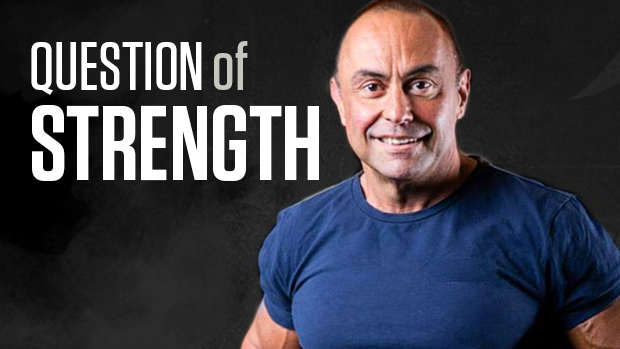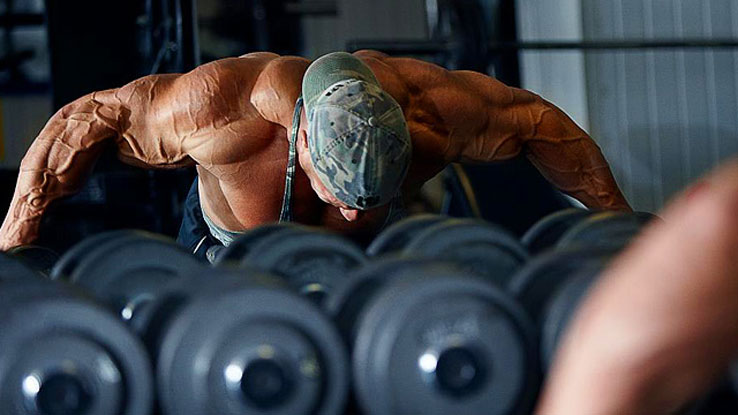Q: Football season is coming up. I'm still a few pounds underweight and need to gain weight fast. Any tricks that can put me in an anabolic state faster?
A: I'd say that your best bet is to use branched-chain aminos while you train. I learned this trick from Dr. Serrano and Dr. DiPasquale and have been using it with athletes who have difficulty gaining size. What we've found is that there's a serious decrement in post-workout soreness when you use BCAA during the training session. I recommend taking 0.44 g per kg of bodyweight. In other words, if you weigh 90 kilograms (198 pounds), take 40 grams of branched-chain amino acids. If you're on a restricted budget, use at least 20 grams. If you can't afford that much, don't bother. Of course, you could save your BCAA loading for those days when you train your weakest body parts, and that'll allow you to save some money.
How does it work? Well, BCAAs consumed during training raise both growth hormone and insulin at the same time, hence the increased anti-catabolism and anabolism. Of course, the study by Carli et al. (1992) showed that supplementing with branched-chain amino acids prior to a workout not only prevents a decrease in post-workout testosterone levels, but actually allows testosterone levels to increase following exercise.
There are two ways to ingest them: tablets/capsules or powder. If you prefer to use tablets or capsules, I recommend that you use Muscle Mass from Beverley International. Swallow three to four capsules every time you sip water. If you'd rather take the powdered form, you can use Gluta Cene from Advanced Genetics. It contains both branched-chain amino acids and glutamine that's meant to be mixed in water and sipped throughout a workout. Since BCAAs are very disgusting in taste, the company has managed to mask the flavor quite adequately. My athletes agree that grape is the most palatable of all of the flavors. To contact Advanced Genetics, call 888-629-6277.
Q: You're obviously the "king of the ring" when it comes to improving performance using weight training, but what suggestions would you have for mental/psychological conditioning? Surely, the mind plays an important role in elite level sports. Have you seen anything in the elite world that would benefit average lifters?
A: Your question reminds me of something that happened at the Nagano Winter Olympics. There were a few of us sitting around at the cafeteria in between events, just shooting the breeze. Then one freestyle skier asked my client, Al MacInnis (the man with the strongest slapshot in the NHL and winner of this year's Norris Trophy for best defenseman in the league):
"Al, do you guys use sports psychologists in the NHL?"
To which Al answered in his usual dry, sarcastic humor:
"No, because we have the American League where we ride the bus for 16 hours a day, sleep at a Motel 6, and eat at Taco Bell, kid. That'll straighten out anybody's attitude..."
In other words, not everyone needs that sort of thing. Still, there are a lot people who swear by it. Even so, not all psychological conditioning methods have merit in increasing strength. Mental rehearsal and self talk are poor tools for strength increases, while activation techniques can make a significant difference. And the psychological techniques that increase strength have different effects on different people. For example, while hypnosis can increase strength up to 40% in novice lifters, it rarely helps elite lifters improve by as little as 10%...and that's if you're respondent to hypnosis. The ability to get into a hypnotic state follows a descendent curve in the population. A disproportionately low number of people reach a hypnotic state that enhances performance.
Even though mental skills can be acquired through learning, it's my opinion that the superior mental proficiencies of elite athletes are more innate than learned. I doubt that Arnold Schwarzenegger took Visualization 101 in high school to achieve the success he had in his early teens.
Still, if you lack the funds, the means, or the stomach for a "visualization coach," you might want to try "psychological conditioning in a can," otherwise known as Power Drive.
Q: I'm a high school basketball player, so my ears really perk up when someone talks about increasing vertical jump. While I know that genetics are involved, all I need are a couple more inches to dunk the ball. You've said something about doing power cleans and explosive movements to help increase vert. Aren't these football exercises? My basketball coach just has us do speed reps with light weight, usually in combination with circuit training. Is there any hope for me?
A: If power cleans and explosive lifts were football-only exercises, then I guess open-handed geek slapping would be a table tennis-only exercise.
Editor's note: I have no idea what the preceding analogy means, and Charles only gives me a dirty look when I ask him. A free T-shirt to the first person who can explain it to me.
Improvements in the Olympic lifts and their variations, plus increases in the amount of weight you use for squatting, are your guarantee to an improved vertical jump.
As far as doing speed reps with light weights, they don't favor the recruitment of high-threshold fibers like rapidly accelerating heavy loads will. Doing speed reps in conjunction with circuit training is even more useless, as the lactate buildup will drive the blood pH downward, thus making the blood more acidic and impairing the recruitment of high-threshold motor units.
Does your high school also tell you that you can catch herpes from a toilet seat and that smoking one joint will make you a crack addict in less than three days? Your high school coach reminds me of a supplement company owner who thought that eating kangaroo meat would increase his vertical jump. I don't want to embarrass him by revealing his name, but let's just say that his initials are James Bradshaw of Pump magazine.
Q: Can I get really strong without putting on too much weight? I noticed that most champion powerlifters are fat. Franco Columbu seemed to look good and be strong enough to compete in powerlifting, but he's in the minority.
A: Of course you can. The reason you perceive powerlifters as fat is because TV likes to show the people who lift the most amount of weight and focusses on the super heavyweight class, members of which tend to have a higher percentage of body fat. This just isn't true of competitors in the lighter weight divisions. For instance, when Mauro DiPasquale, MD dominated the World Championships in the 148-pound and 165-pound weight classes, his body fat percentage was close to 3%.
Also, you might've only seen American powerlifters who tend to have higher body fat percentages because of their diets. Look at world-class powerlifters from Finland, Japan, and Sweden – most of them are on the lean side, with body fat percentages under 7% in most weight classes.
When training for relative strength, as stated previously in some of my writing, the following loading parameters apply in training with maximal weights:
- Intensity should be between 85% and 100% (the weight used should be between 85% and 100% of the maximum amount of weight that you can lift for one rep).
- Rep range should be between one and five.
- The number of sets should fall between five and twelve.
- Rest intervals between sets should be four to five minutes.
- The time that takes you to raise the weight should be between one and four seconds.
- The time that it takes you to lower the weight should be between three and five seconds.
- You should pause between the raising and lowering part of the rep for one to four seconds.
- A set shouldn't take longer than 20 seconds to complete.
Because of the high number of sets that you'll be doing for this type of routine, you'll only need to do one to three exercises per workout. You could, however, do as many as four if you pair agonists and antagonists together (opposite muscle groups: back and chest, biceps and triceps, or quads and hamstrings), as opposed to working agonists alone.
Researchers have found that the ability to achieve full motor unit activation (MUA) is enhanced when immediately proceeded by a contraction of the agonists. For example, after doing a three-repetition maximum (3RM) set of close-grip triceps presses, rest two to three minutes and perform a 3RM or 4RM set of dumbbell curls for the biceps. Rest two to three minutes and repeat for the required amount of sets. This method has the added benefit of allowing you to double the workload per training session.
Q: You've always been openly critical of Joe Weider and Nautilus guru Arthur Jones. What's wrong? Didn't these guys pave the way for modern training techniques?
A: Stop it, you're killing me! My spleen's about to rupture. Were you dropped on your head as an infant...for a set of fifteen...from the second floor, or are your parents cousins?
Did they pave the way for modern training techniques? No. But they did make very significant contributions to the fitness industry.
Joe Weider, besides claiming to have invented the hole in donuts (better known as the "Joe Weider donut hole principle"), popularized bodybuilding as a mainstream activity through his many magazines. He had the genius to recognize the amazing marketing potential of Arnold Schwarzenegger, who was the true factor behind the general public's acceptance of pumping iron.
Likewise, his brother Ben has been trying for years to legitimize bodybuilding by lobbying to have it accepted as an Olympic sport. Unfortunately, based on the present IOC standards, bodybuilding should make it the same year as dwarf throwing, underwater hockey, and surf skeetshooting.
Arthur Jones was the greatest tonic the fitness club industry's ever known. During the '70s, his ideas led to the birth of hundreds of Nautilus clubs that eventually graduated to larger clubs with more free-weight apparatus, which then converted to health and fitness clubs. I can honestly say that he created a whole new industry of better-designed strength-training equipment by setting up a new standard, but the training methodology that he advocated has been refuted by controlled scientific studies many times over. That is one of the reasons why his biggest cult disciple, Mike Mentzer, was booted out of Muscular Development magazine (MD column writers such as the highly respected sports scientist William Kraemer kept demonstrating with plenty of scientific studies that Mentzer's training dogma went out of style about the same time as the notion that the Earth is flat).
All fun aside, they did contribute some valuable things. But in this day and age, it all comes down to "what have you done lately?"
Q: You've mentioned "dynamic stretching" several times. What exactly is that, anyway?
A: Dynamic stretching is also called ballistic stretching, among other things. Unfortunately, it's gained an undeserved bad reputation, thanks to physical therapists and athletic trainers who have claimed that it's a sure way to injure yourself.
Contrary to popular belief, there's very little correlation between static flexibility and dynamic flexibility. That's why you see black belts in karate who can kick you in the face, yet they can barely touch their mid-shins with the tips of their fingers when they bend over. If ballistic stretching was so stressful, though, every martial artist who emphasizes kicking in his style (Tae Kwon-Do, Hapkido, Savate) would be dead, as would every rhythmic gymnast, artistic gymnast, ballet dancer, and diver – ballistic stretching is a staple of their physical preparation. Interestingly enough, when the Philadelphia 76ers won the NBA championship in 1986, their strength and conditioning coach was a ballet teacher who used plenty of ballet-type movements to teach the basketballers how to use the concept of acceleration and learn to relax the antagonistic muscles.
Dynamic stretching involves fast movements which place the muscles under a rapid, but very short-lived, stretch. Opponents of dynamic stretching will argue that the imposed stretch is too small in terms of time to be beneficial and increases the likelihood of muscle pull. But what these people fail to understand is that the correlation between dynamic flexibility and static flexibility (r=0.42) is quite poor. In other words, it's possible that someone who can barely touch his mid-shins in a sit-and-reach" test (static stretch) can kick you in the face (dynamic stretch). Similarly, someone who can go beyond his feet in a sit-and-reach test can barely kick you in the navel. In the dynamic expression of flexibility, there's more involved than the ability to relax the muscles and connective tissue. It also requires the ability to activate the antagonist muscle to place the muscles in a rapid stretch. So, in our kicking example, you may able to stretch your hamstrings well in a slow sit-and-reach test, but your may not be able activate the quadriceps at high speeds to place the hamstrings in a rapid stretch.
There is a correct way to do ballistic stretches, however – the pendulum method. Don't try to reach maximal range in the first stretch. Rather, build up to it. So, for example, to warm up for a high kick, you'd first kick at the ankle level for starters, then aim at mid-shin, then kneecap, etc., until you reach your maximal kicking height. But you definitely wouldn't start out with your best impression of a Jean-Claude Van Damme kick.




